
Fashion Snoops expert trend forecaster Jay Anna Mize looks at what's now and what's next in style and consumer
buying behaviors
as we exit the
pandemic.
It’s been over a year since Furniture World last spoke with Jaye Anna Mize about consumer behaviors, culture, lifestyles and home furnishings trends. Mize is VP of Creative Home Interiors and Design at the trend forecasting think-tank Fashion Snoops. We asked her to update her expectations for the furniture business going forward.
We are seeing that younger consumers want fewer, better things. This is a trend I shared with Furniture World
in late 2019. It's
accelerating.
|
“The focus on the home has obviously boomed due to COVID,” she observed. “Consumers are working on their homes which is a beautiful thing. However, there are a lot of sourcing issues including backorders, manufacturing and shipping delays.”
Potential Problems Ahead
“Just about everyone in our industry knows that importing from Asia right now is literally like the wild, wild West. It’s been impossible for brands to know what can be made and when it will be delivered. Lots of factories are working short-staffed and at different intervals so retailers, importers and consumers have had to adjust expectations.
“There's a huge demand-supply mismatch that we as an industry desperately need to work out. At the same time, we are seeing that younger consumers want fewer, better things. This is a trend I shared with Furniture World in late 2019. It’s a trend that's accelerating as older generations want to declutter and buy more quality-driven items as well.”
Mize says that supply issues coupled with declining demand will result in problems for the home furnishings industry. “At Fashion Snoops we are concerned that importers and retailers will accidentally overbuy, thinking that the unusually high demand during COVID will continue. We forecast that a lot of people are going to spend less on home furnishings post-pandemic.
“Early in the pandemic when many people started working from home they purchased a quick-fix desk. Now they are focused on replacing it with something better. People will put more emphasis on purchasing quality-crafted, locally-made products, and the trend toward buying more expensive furnishings online will continue. The pandemic has made consumers comfortable with buying higher priced items online without seeing them in person first.”
Fashion Snoops does a huge amount of research when compiling yearly projections. They scan the internet and peruse tons of periodicals. In normal years they travel relentlessly to collect information on all aspects of design, consumer behavior, culture and lifestyles. “This year,” noted Mize, “there has been an unusually slow progression of new home furnishings designs due to COVID.
“Overall, the structure and sentiment of recent design trends hasn’t changed much. We see a slow evolution as opposed to revolutionary change.”
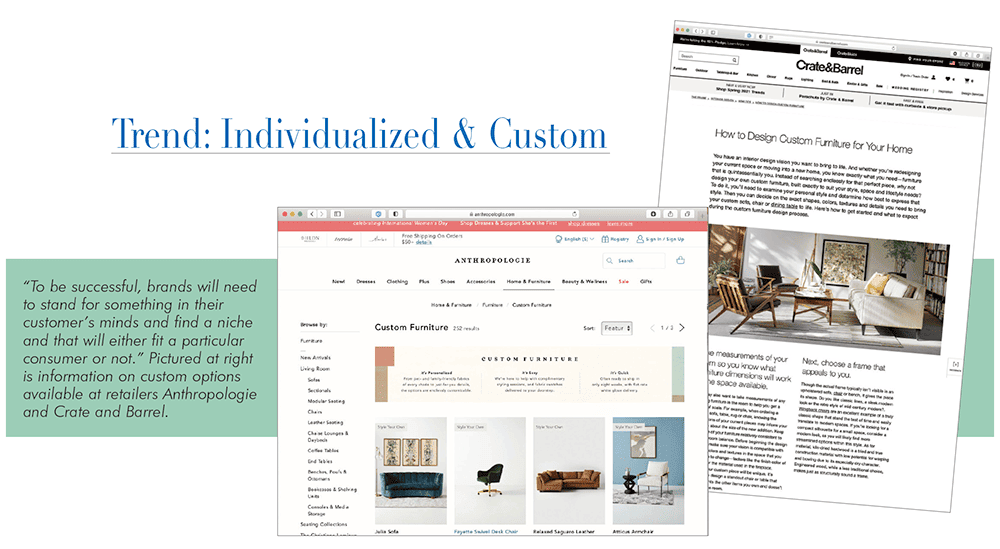
Personalization
“Individualization and customization in the home has become more important. From a trend perspective, the industry is gravitating away from the idea of bucketed trends such as shabby chic, farmhouse, maximalism, minimalism and lux modern.
It’s not good enough anymore for a company to not use child labor or stop supporting toxic working environments. It’s becoming a deeper and more difficult
conversation about materials and practices.
|
“I don't think that we will see a color boom, a printing pattern boom or a shape boom any time soon. Instead, there will be more design individuality. To be successful, brands will need to stand for something in their customers' minds and find niches and that will either fit a particular consumer or not.
“Target has stayed ahead of this trend by starting to segment their home brands. Each one has a different voice,” she noted. “They're not trying to offer the widest selection and be all things to all customers. I think it's a really smart move.”
Self Reliance
“Consumers have come around to the realization that they should be more self-reliant. The pandemic reminded them that they have forgotten how to do things that are basic to sustaining life such as gardening and cooking. So, one of the biggest things Fashion Snoops is forecasting post-pandemic is a push towards self-sustainable hands-on lifestyles. Buckets of consumer-driven buying behaviors will arise. Gardening is going to be one of these big buckets. More companies will start injecting garden indoor-outdoor living essentials into product lines. Another bucket will be items for the kitchen. Brands will be looking at, and developing products to address where people are spending most of their time.”
Mize said that this will be an opportunity for furniture retailers. “There will be a lot of opportunities for furniture makers and retailers to get more hands-on with consumers. This will take the form of engaging consumers with D2C marketing to create a more emotional connection.”
She’s not suggesting that there will be a desire in the marketplace to undertake huge projects like buying unfinished furniture. Instead, giving consumers practical interior design ideas with a DIY component and customization options promises to be a successful strategy.
“There is also an opportunity for furniture stores to become a liaison between smaller and custom furniture makers. The idea is to offer customers the experience of choosing individualized custom options and personify the process. It’s a bit like The Container Store’s approach to offering custom closets,” she pointed out.
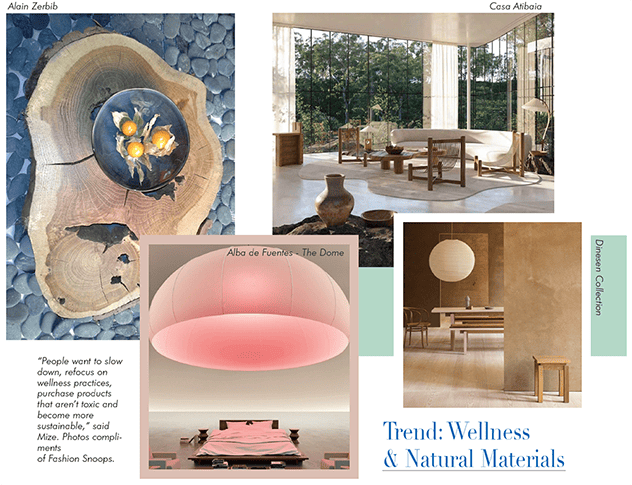
Politics & Design
FURNITURE WORLD asked Mize if recent political and social movements have affected home furnishings style trends. “That’s an interesting question for this recent cycle,” she replied. “Usually in an election year, consumers gravitate more towards traditional furnishings because they feel more patriotic. Forecasters notice traditional furniture purchases start to up-tip before an election, a trend that typically follows through for perhaps the next year and a half. For example, Joanna Gaines' career took off about the same time that Obama was elected president. Consumers really felt the pull towards a new Americana with the 2012 election and Gaines' design aesthetic fit in well with that need. However, as we've moved into 2021, we see a lot less traditional, patriotic and industrial feeling home furnishings. Instead of red, white and blue, people are looking for design that’s more primal, tied into their ancestry and roots.”
Sustainable Design
Instead of red, white and blue, people are looking for design that’s more primal, tied into their ancestry and roots.
|
“Fashion Snoops recently partnered with Julia Watson, who created a style known as ‘radical indigenism.’ Her designs study indigenious communities and how their primal habitats work in reciprocity with nature. Conversations about concepts like this will be key for home furnishings marketing materials going forward. More people want to know how furniture brands and retailers are working with the Earth to preserve it. That is a big shift for consumers, especially younger ones who are pushing this agenda forward. Our industry has observed and discussed this idea before, but never on such a fundamental level.
“That’s why the sooner home furnishings companies address working with nature—using circular design philosophies and principles—the easier it will be for their supply chains to adapt over the next 20 to 30 years. An end-game strategy is needed because more people have become hyper-aware, nervous, and super concerned that consumer lifestyles are killing the planet. It’s not good enough anymore for a company to not use child labor or stop supporting toxic working environments. It’s becoming a deeper and more difficult conversation about materials and practices.”
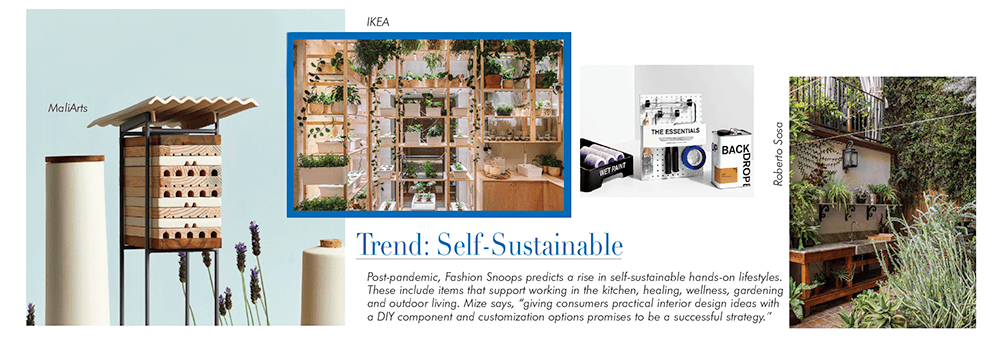
Other Opportunities
Mize says that our customers are becoming super skeptical as well. “Going forward,” she explained, “companies must document their progress and offer proof. That's because consumers are seeing more value in retailers and brands that embrace transparent business and sourcing practices.”
We spoke about CITY Furniture’s social responsibility report (highlighted in this edition of Furniture World). This retailer is adapting clean technologies such as natural gas delivery trucks, electric vehicles and solar power. With regard to sourcing, however, they say that they are really just getting started.
Mize suggested that retailers like CITY Furniture should start by reviewing their corporate mission. “We love the initiative and hope they keep up with their due diligence because at the end of the day, it's our responsibility as members of this industry to not ruin this planet.
“We are seeing consumers making more sustainable choices as they become available in bedding, rugs and furniture. Truthfully though, there aren’t a lot of satisfying eco-friendly furniture choices out there.”
Wellness Trend
“A broad consumer interest in sanctuary and wellness-driven living has developed. There has been a huge uptick in people building wellness spaces within their homes—meditation spaces, places to do yoga and home workouts.”
Mize says that people feel like they’ve been on an insane roller-coaster without much work-life balance. “That’s been part of the COVID experience for sure. It’s all part of a trend that goes hand-in-hand with people wanting to slow down, refocus on wellness practices, purchase products that aren’t toxic and become more sustainable.”
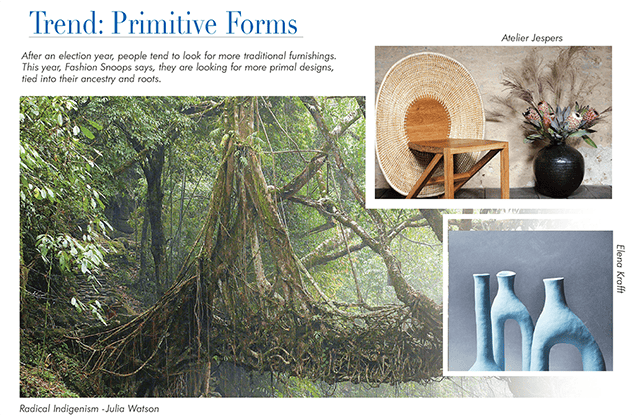
With regard to companies that are doing a good job of addressing sustainable trends, she observed that, “the ones nailing it right now are primarily smaller maker-driven furniture manufacturers adding upcycled and recycled content which will be more important from a marketing perspective going forward.
“During COVID, protection has become more important. People who are redoing their homes are emphasizing automated appliances, installing air filter systems and purifying fabrications to protect home environments. IKEA recently started selling a line of purifying curtains by GUNRID made from recycled PET bottles. When activated by daylight they reduce home pollutants. We will see more cooling and purifying finishes, especially in the bedding category. Also, look for more recycled materials, vegan leathers, stoneware and unusual, renewable natural materials.”
Be Happy
There is a lot more happiness coming through in home furnishings design.
|
Fashion Snoops has identified a new trend they call 'Joyland.' “It is all about being happy, said Mize. These furnishings have bright, bold colors and nostalgic throwbacks embraced by younger consumers as they step up to buy homes. There is a lot more happiness coming through in home furnishings design that includes fun interpretations of checks, geos, flex living scenarios and athletic influences.
“This trend is different from maximalism. Absent are the ornate prints thrown up all over rooms. Instead, it includes highly color blocking highlighted by fun, thoughtful statement pieces. It’s way more playful.”
Emphasis on Materials
“I feel that materials will be in the forefront of home furnishings for the next two to five years. People will be less focused on a theme or a trend. Instead, they will be more concerned with material applications and how those materials are being sourced.”
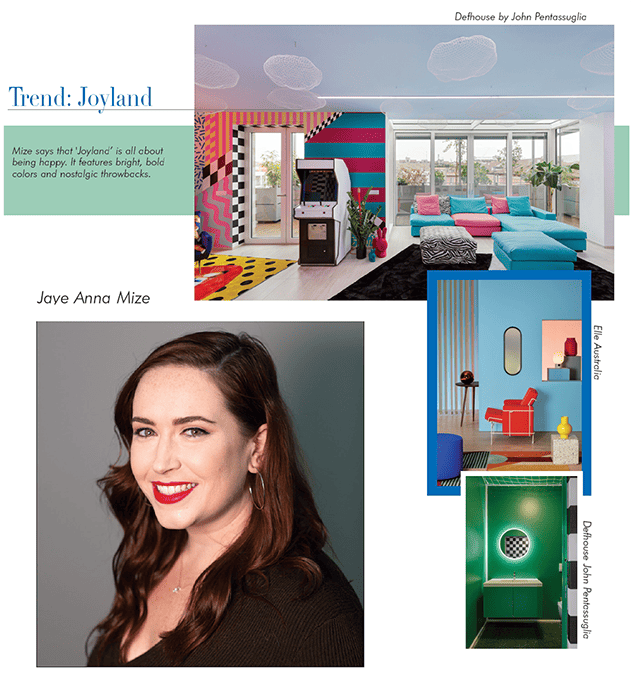
About Fashion Snoops (FS): FS is a global trend forecasting agency that helps companies harness future trends. Merging research and IT, the company provides a collaborative trend platform for creatives - a one-stop-shop to explore new trends, create and share new concepts. Visit Fashion Snoops at https://fashionsnoops.com.
Furniture World is the oldest, continuously published trade publication in the United States. It is published for the benefit of furniture retail executives. Print circulation of 20,000 is directed primarily to furniture retailers in the US and Canada. In 1970, the magazine established and endowed the Bernice Bienenstock Furniture Library (www.furniturelibrary.com) in High Point, NC, now a public foundation containing more than 5,000 books on furniture and design dating from 1620. For more information contact editor@furninfo.com.